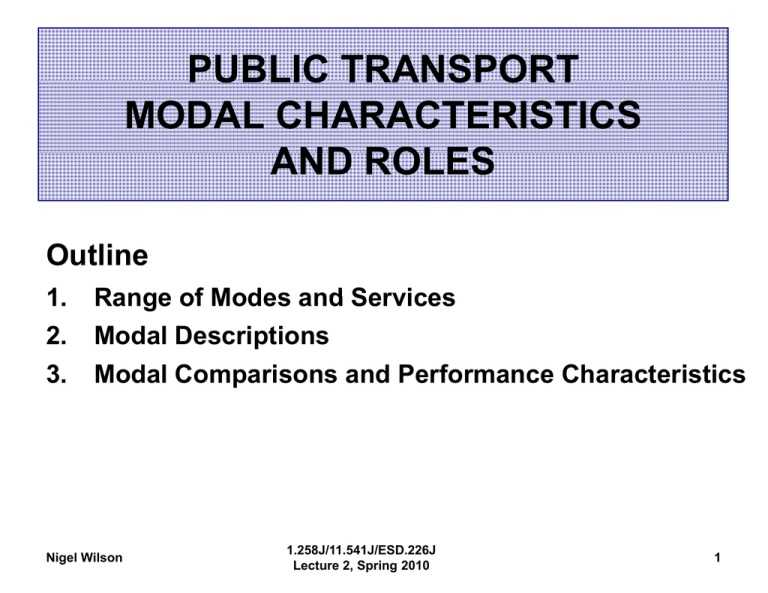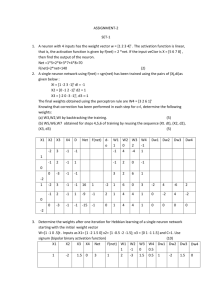Document 13376306
advertisement

PUBLIC TRANSPORT TRANSPORT MODAL CHARACTERISTICS AND ROLES Outline 1. Range of Modes and Services 2. Modal Descriptions 3. Modal M d l Comparisons C i and d Performance P f Characteristics Ch t i ti Nigel Wilson 1.258J/11.541J/ESD.226J Lecture 2, Spring 2010 1 Roles for Each Mode Low density flows Spread O-D flows --------> --------> High density flows Concentrated O-D flows Auto-> Car pools -> Van pools Automated guideway y subscription bus taxi -> shared ride taxi -> publicos -> fixed bus route -> light rail -> heavy rail Nigel Wilson 1.258J/11.541J/ESD.226J Lecture 2, Spring 2010 2 Spectrum p of Services Increasiing vehi hiclle capaciity -----> Increasing passenger flows -----> Vehicle Type Car Van Minibus Free Right of way Routing and Scheduling Nigel Wilson Light Heavy Rail Rail Operating Arrangements Drivers Bus Low Cost Shared Flexible Hybrid 1.258J/11.541J/ESD.226J Lecture 2, Spring 2010 High Cost (conventional transit)) Low Cost (automated) Dual Mode Dedicated Fixed 3 Transit Categories g (based ( on Vuchic)) 1. Rights of Way Based on deg gree of seg greg gation • Surface with mixed traffic: buses, light rail: with/without preferential treatment • Longitudinal separation but at-grade crossing interference: light rail, bus rapid transit • F ll separation: Full ti att-grad de, tunnel, t l ellevatted d Nigel Wilson 1.258J/11.541J/ESD.226J Lecture 2, Spring 2010 4 Transit Categories g ((cont’d)) 2. Technologies Key ytechnolo gical characteristics: (a) Support - contact between vehicle and surface • rubber tire on concrete • steel wheel on steel rail • others (b) Guidance - lateral control: • steered by driver • guided by track • others Nigel Wilson 1.258J/11.541J/ESD.226J Lecture 2, Spring 2010 5 Transit Categories g ((cont’d)) 2. Technologies (cont'd) ((c)) Prop pulsion: • diesel ICE: conventional or clean • CNG • ellectri t ic motor t • hybrid • ot e s others (d) Control • manual/visual • manual/signal • automatic: ATO, ATC Nigel Wilson 1.258J/11.541J/ESD.226J Lecture 2, Spring 2010 6 Basics of Train Control • Tracks are divided into fixed "blocks" (track circuits), ranging from hundreds to thousands of meters in length • Max speed in a block is based on track geometry and the location of the preceding train Max Speed (mph) 40 25 10 0 Position of Preceding Train Di ti off Movement Direction M t Block Boundaries • Block desig gn is critical to service quality yand ca pacity y Nigel Wilson 1.258J/11.541J/ESD.226J Lecture 2, Spring 2010 7 Example p MBTA Red Line southbound KENDALL/MIT CHARLES/MGH PARK ST DOWNTOWN CROSSING • train cannot enter Park St until the preceding train has departed Downtown Crossing • minimum headway is: Close in Time + Dwell time at Park + Running time Park⇒Downtown Crossing Close-in + Dwell time at Downtown Crossing + Exit time -- approximately 3 minutes Nigel Wilson 1.258J/11.541J/ESD.226J Lecture 2, Spring 2010 8 Levels of Automated Protection • None (MBTA Green G Line)): advisory wayside signals • Manual setting of speed below the maximum level plus dwell ll ti times (MBTA R Red d Li Line)): in-cab i b signal i ls • Manual setting of dwell time only (WMATA) • Automatic Train Supervision/Regulation: Tren Urbano, LUL Central Line • Full automation LUL Jubilee Line-London, RER-Paris pacity y increased throug gh moving g block or • Cap Communication-Based Train Control (NYCT Canarsie Line) Nigel Wilson 1.258J/11.541J/ESD.226J Lecture 2, Spring 2010 9 Modal Descriptions p Bus: vehicles operating individually with rubber tires, Bus: with manual lateral and longitudinal control K d Key deciisions: i Vehicle size: minibus (20 passengers) up to bi-articulated (165+ passengers) Vehicle design: high floor or low floor Right-of Right of-way: way: all options are available Guidance: locations? is guided operation appropriate at some Propulsion: all options available Fare payment: on-vehicle or off-vehicle Nigel Wilson 1.258J/11.541J/ESD.226J Lecture 2, Spring 2010 10 Modal Descriptions p ((cont’d)) Light Rail: vehicles operating individually or in short trains with electric motors and overhead power collector, steel wheel on steel rail with manual or automatic longitudinal control Key decisions: • Vehicle design: high floor or low floor, floor articulated or rigid body • Right-of-way: all options available • Operating arrangements: automated or manually driven Nigel Wilson 1.258J/11.541J/ESD.226J Lecture 2, Spring 2010 11 Modal Descriptions p ((cont’d)) Heavy Rail/Metro: vehicles operating in trains with electric motors on fully separated rights-of-way with manual signal or automatic longitudinal control; level boarding, off-vehicle fare payment Key decisions: • Train length • Right-of-way: at-grade, elevated, or tunnel • St Stati tion spaciing • Operating arrangements: degree of automation Nigel Wilson 1.258J/11.541J/ESD.226J Lecture 2, Spring 2010 12 Modal Descriptions p ((cont’d)) Commuter Rail: vehicles operating in trains with long station spacing, serving long trips into central city, large imbalance between peak hour and other period ridership. Key decisions: • • • • • Fare coll llecti tion sttrattegiies Line length Through routing in CBD Station spacing Extent of parking gca pacity y Nigel Wilson 1.258J/11.541J/ESD.226J Lecture 2, Spring 2010 13 Traditional Transit Services • • • • Bus on sh B hared d riight ht-off-way Streetcar on shared right-of-way Heavy rail on exclusive right right-of of-way way Commuter/Regional rail on semi-exclusive right-of-way Newer Service Concepts • B Bus R Rapid id Transit T it (including (i l di exclusive l i lanes l and/or d/ TSP) • Light Rail on exclusive right-of-way Nigel Wilson 1.258J/11.541J/ESD.226J Lecture 2, Spring 2010 14 Increasing Diversity • • • • • • Driver arrangements: part-timers, 10-hour days, pay by vehicle type Routing and scheduling: fixed, flexible, advance b ki booking Vehicle types: minibuses, articulated buses and railcars, il bi-level bi l l railcars, il low-floor l fl Control options: fixed block, moving block, manual ATO manual, ATO, ATC Priority options: full grade separation, semi- exclusive right right-of-way, of way signal pre pre-emption emption Dual mode operations: bus, light rail Nigel Wilson 1.258J/11.541J/ESD.226J Lecture 2, Spring 2010 15 Modal Comparison: p Bus vs. Rail Rail advantages: Bus advantages: • High capacity • Low capital costs • Lower operating costs • Wide network coverage • Better service quality • Single vehicle trips • Stronger land use influence • Flexibility • Fewer negative externalitities • “Dual mode” nature Nigel Wilson 1.258J/11.541J/ESD.226J Lecture 2, Spring 2010 16 2007 US Transit Mode P f Performance M Measures Bus Operating Expenses ($ millions) Heavy Rail Light Rail Commuter Rail Paratransit 17,308 5,888 1,170 4,015 4,421 5,412 3,460 419 459 209 20,978 16,138 1,932 10361 1,502 Annual Revenue Vehicle Miles (RVM) 1987 638.5 82.7 297.4 1,274 Annual Revenue Vehicle Hours (RVH) 158 31.8 5.5 9.5 105.2 Op Cost/RVH ($) Op. 110 185 15 185.15 212 72 212.72 422 63 422.63 42 0 42.0 Op. Cost/RVM ($) 8.7 9.22 14.14 13.5 3.47 Op. Cost/Unlinked Pass Trip ($) 3.2 1.7 4.22 8.75 21.15 O Cost/Pass Op. C t/P Mil Mile ($) .83 83 .36 36 .61 61 0 39 0.39 2 94 2.94 34.3 108.8 76.18 48.3 1.99 132.8 507.48 351.27 1,090.63 14.27 3.9 4.7 4.6 24.3 7.2 Mean Pass Load 10.6 25.3 23.4 37.5 1.2 Mean Operating Speed (mph) 12.6 20.1 15.1 31.4 12.1 Annual Unlinked Passenger Trips (millions) Annual Passenger Miles (millions) Unl. Pass Trips/ RVH (millions) Pass Miles/RVH Mean Trip Length (miles) Nigel Wilson 1.258J/11.541J/ESD.226J Lecture 2, Spring 2010 17 Ridership p Trends by y Mode 2007 Ridership (Millions) Ridership Change 1970-2007 Percent Change 1970-2007 5 old systems 2908 1227 +65% 7 new systems 552 7 old ld systems 1 9 179 -56 6 -24% 24% 23 new systems 240 4 old sy ystems 409 129 +46% Mode Heavy Rail Light Rail Commuter Rail 16 new systems 50 Bus 5,413 378 +8% Total - all modes* 9 750 9,750 2 320 2,320 ≈ +40% * includes other modes such as paratransit and trolleybus "Old" systems began pre-1970; "New" systems began post-1970 Nigel Wilson 1.258J/11.541J/ESD.226J Lecture 2, Spring 2010 18 Chang ges in Service Provided (1997-2007) by Mode Active A ti Vehicles Heavy Rail +10% +18% Light Rail +68% +105% Commuter Rail +18% +30% +14%1 +7% Bus 1 Series Revenue V R Vehicle hi l Miles Operated changed in 2007. For bus, change is 1997-2006 Nigel Wilson 1.258J/11.541J/ESD.226J Lecture 2, Spring 2010 19 Service Utilization Trends by y Mode Boardings/Vehicle Mile Mode 2007 Passenger Load % change 1997-2007 Mode 2007 % change 1997-2007 Heavy Rail 5.4 +20% Heavy Rail 25.3 +13% Light Rail 5.1 -22% Light Rail 23.4 -15% Commuter Rail 1.5 -1% Commuter Rail 37.5 +7% Bus 2.7 +10% Bus 10.6 +9% Nigel Wilson 1.258J/11.541J/ESD.226J Lecture 2, Spring 2010 20 MIT OpenCourseWare http://ocw.mit.edu 1.258J / 11.541J / ESD.226J Public Transportation Systems Spring 2010 For information about citing these materials or our Terms of Use, visit: http://ocw.mit.edu/terms.
